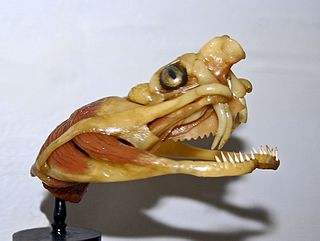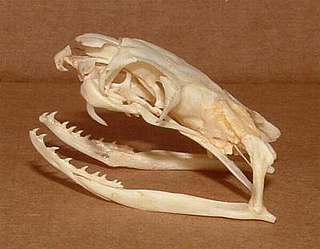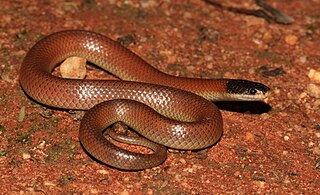Related Research Articles

Elapidae is a family of snakes characterized by their permanently erect fangs at the front of the mouth. Most elapids are venomous, with the exception of the genus Emydocephalus. Many members of this family exhibit a threat display of rearing upwards while spreading out a neck flap. Elapids are endemic to tropical and subtropical regions around the world, with terrestrial forms in Asia, Australia, Africa, and the Americas and marine forms in the Pacific and Indian Oceans. Members of the family have a wide range of sizes, from the 18 cm (7.1 in) white-lipped snake to the 5.85 m king cobra. Most species have neurotoxic venom that is channeled by their hollow fangs, and some may contain other toxic components in various proportions. The family includes 55 genera with around 360 species and over 170 subspecies.

The Viperidae (vipers) are a family of snakes found in most parts of the world, except for Antarctica, Australia, Hawaii, Madagascar, New Zealand, Ireland, and various other isolated islands. They are venomous and have long, hinged fangs that permit deep penetration and injection of their venom. Three subfamilies are currently recognized. They are also known as viperids. The name "viper" is derived from the Latin word vipera, -ae, also meaning viper, possibly from vivus ("living") and parere, referring to the trait viviparity common in vipers like most of the species of Boidae.

Acanthophis is a genus of elapid snakes. Commonly called death adders, they are native to Australia, New Guinea and nearby islands, and are among the most venomous snakes in the world. Despite their common name, they are not adders at all and belong to the Elapidae family. The name of the genus derives from the Ancient Greek akanthos/ἄκανθος ('spine') and ophis/ὄφις ('snake'), referring to the spine on the death adder's tail.

Taipans are snakes of the genus Oxyuranus in the elapid family. They are large, fast-moving, highly venomous, and endemic to Australia and New Guinea. Three species are recognised, one of which, the coastal taipan, has two subspecies. Taipans are some of the deadliest known snakes.

A snakebite is an injury caused by the bite of a snake, especially a venomous snake. A common sign of a bite from a venomous snake is the presence of two puncture wounds from the animal's fangs. Sometimes venom injection from the bite may occur. This may result in redness, swelling, and severe pain at the area, which may take up to an hour to appear. Vomiting, blurred vision, tingling of the limbs, and sweating may result. Most bites are on the hands, arms, or legs. Fear following a bite is common with symptoms of a racing heart and feeling faint. The venom may cause bleeding, kidney failure, a severe allergic reaction, tissue death around the bite, or breathing problems. Bites may result in the loss of a limb or other chronic problems or even death.

Snake venom is a highly toxic saliva containing zootoxins that facilitates in the immobilization and digestion of prey. This also provides defense against threats. Snake venom is injected by unique fangs during a bite, whereas some species are also able to spit venom.

Envenomation is the process by which venom is injected by the bite or sting of a venomous animal.
Devocalization is a surgical procedure where tissue is removed from the vocal cords.

The eastern brown snake, often referred to as the common brown snake, is a species of extremely venomous snake in the family Elapidae. The species is native to eastern and central Australia and southern New Guinea. It was first described by André Marie Constant Duméril, Gabriel Bibron, and Auguste Duméril in 1854. The adult eastern brown snake has a slender build and can grow to 2 m (7 ft) in length. The colour of its surface ranges from pale brown to black, while its underside is pale cream-yellow, often with orange or grey splotches. The eastern brown snake is found in most habitats except dense forests, often in farmland and on the outskirts of urban areas, as such places are populated by its main prey, the house mouse. The species is oviparous. The International Union for Conservation of Nature classifies the snake as a least-concern species, though its status in New Guinea is unclear.

The red-bellied black snake is a species of venomous snake in the family Elapidae, indigenous to Australia. Originally described by George Shaw in 1794 as a species new to science, it is one of eastern Australia's most commonly encountered snakes. Averaging around 1.25 m in length, it has glossy black upperparts, bright red or orange flanks, and a pink or dull red belly. It is not aggressive and generally retreats from human encounters, but can attack if provoked. Although its venom can cause significant illness, no deaths have been recorded from its bite, which is less venomous than other Australian elapid snakes. The venom contains neurotoxins, myotoxins, and coagulants and has haemolytic properties. Victims can also lose their sense of smell.

Snake charming is the practice of appearing to hypnotize a snake by playing and waving around an instrument called a pungi. A typical performance may also include handling the snakes or performing other seemingly dangerous acts, as well as other street performance staples, like juggling and sleight of hand. The practice was historically the profession of some tribesmen in India well into the 20th century but snake charming declined rapidly after the government banned the practice in 1972. Snake-charmer performances still happen in other Asian nations such as Pakistan, Bangladesh, Sri Lanka, Thailand and Malaysia. The tradition is also practiced in North African countries of Egypt, Morocco, and Tunisia.

Toxicofera is a proposed clade of scaled reptiles (squamates) that includes the Serpentes (snakes), Anguimorpha and Iguania. Toxicofera contains about 4,600 species, of extant Squamata. It encompasses all venomous reptile species, as well as numerous related non-venomous species. There is little morphological evidence to support this grouping; however, it has been recovered by all molecular analyses as of 2012.

Boiga dendrophila, commonly called the mangrove snake or the gold-ringed cat snake, is a species of rear-fanged venomous snake in the family Colubridae. The species is endemic to southeast Asia. It is one of the biggest cat snake species, averaging 8–9 feet in length. It is considered mildly venomous. Although moderate envenomations resulting in intense swelling have been reported, there has never been a confirmed fatality.

Venomous snakes are species of the suborder Serpentes that are capable of producing venom, which they use for killing prey, for defense, and to assist with digestion of their prey. The venom is typically delivered by injection using hollow or grooved fangs, although some venomous snakes lack well-developed fangs. Common venomous snakes include the families Elapidae, Viperidae, Atractaspididae, and some of the Colubridae. The toxicity of venom is mainly indicated by murine LD50, while multiple factors are considered to judge the potential danger to humans. Other important factors for risk assessment include the likelihood that a snake will bite, the quantity of venom delivered with the bite, the efficiency of the delivery mechanism, and the location of a bite on the body of the victim. Snake venom may have both neurotoxic and hemotoxic properties. There are about 600 venomous snake species in the world.

Veterinary surgery is surgery performed on non-human animals by veterinarians, whereby the procedures fall into three broad categories: orthopaedics, soft tissue surgery, and neurosurgery. Advanced surgical procedures such as joint replacement, fracture repair, stabilization of cranial cruciate ligament deficiency, oncologic (cancer) surgery, herniated disc treatment, complicated gastrointestinal or urogenital procedures, kidney transplant, skin grafts, complicated wound management, and minimally invasive procedures are performed by veterinary surgeons. Most general practice veterinarians perform routine surgeries such as neuters and minor mass excisions; some also perform additional procedures.

The desert death adder is a species of snake native to Australia and is one of the most venomous land snakes in the world. The desert death adder is under threat due to the destruction of habitat.
Raymond Terrence Hoser is an Australian snake-catcher and author. Since 1976, he has written books and articles about official corruption in Australia. He has also written works on Australian frogs and reptiles. Hoser's work on herpetology is controversial, including his advocacy of the surgical alteration of captive snakes to remove their venom glands and his self-published herpetological taxonomy, which has been described as "taxonomic vandalism".

Dwyer's snake also known commonly as the whip snake and the variable black-naped snake, is a species of venomous snake in the family Elapidae. The species is endemic to Australia, where it is found from New South Wales to South Queensland. While closely related to Australian sea snakes, S. dwyeri is a terrestrial reptile.

The Duvernoy's gland is a gland found in some groups of colubrid snakes. It is distinguished from the venom gland and is not found in viperids or elapids. It was named for French zoologist Georges Louis Duvernoy who first described the gland in 1832.
Uatchitodon is an extinct genus of Late Triassic reptile known only from isolated teeth. Based on the structure of the teeth, Uatchitodon was probably a carnivorous archosauromorph. Folded grooves on the teeth indicate that the animal was likely venomous, with the grooves being channels for salivary venom. The teeth are similar to those of living venomous squamates such as Heloderma and venomous snakes. Uatchitodon is the earliest known venomous reptile.
References
- ↑ Jeff Miller Venomoids: An Overview The Southeastern Hot Herp Society March 29, 2001
- 1 2 Venomoid FAQ on snakegetters.com. Accessed Oct 11th 2008.
- ↑ Hoser, R. (2004). "Surgical removal of Venom glands in Australian Elapids-The creation of Venomoids". Herptile. 29 (1): 37–40.
- ↑ R. Hoser Surgical Removal of Venom Glands in Australian Elapid Snakes. The creation of venomoids. Accessed Oct. 11th 2008.
- ↑ Davenport, Clay. "Hybrids and Venomoids And Other Controversial Topics". The last word. Clay Davenport Captive Bred Reptiles. Retrieved 2008-10-16.
- ↑ Veterinary Ethics: What About Venomoids? Venomous Snake Husbandry Basics: Veterinary Care Snakegetters.com, Accessed 15 October 2008
- ↑ Boyer TH (May 2006). "Common procedures with venomous reptiles". The Veterinary Clinics of North America. Exotic Animal Practice. 9 (2): 269–85, vi. doi:10.1016/j.cvex.2006.03.006. PMID 16759947.
- ↑ "Prevention of Cruelty to Animals Act 1986 – Sect 36". Victorian Consolidated Legislation. AustLII. Retrieved 2008-10-16.
- ↑ "Hoser v Department of Sustainability & Environment (Occupational and Business Regulation) [2008] VCAT 2035 (30 September 2008)". Victorian Civil and Administrative Tribunal Decisions. AustLII. Retrieved 2008-10-16.
- ↑ Mex Cooper 'De-venomised' snakes ruled dangerous The Age October 15, 2008